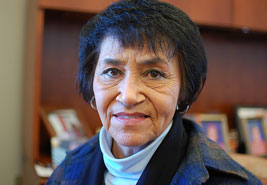When did blood purity replace cultural purity?
By Julianne Jennings
Posted May 08, 2013 in Indian Country Today
Anthropology has from the beginning been influenced and dominated by European males. They set the criteria of hierarchically ordered level descriptions, giving themselves the power to dictate the boundaries of group membership by defining race in terms of biology. As a consequence, the last Indian dies not by blunt force, expulsion or disease, but by the social construction of race imposed upon us— terminating our existence by blood.
Recently, my son Brian and his new wife, Emily, came to visit me in beautiful Montefalco, Italy. It gave me an opportunity to spend time with her and attempt cordial conversations about her background. Emily was born in the Dominican Republic (historically inhabited by the Taino), a nation on the island of Hispaniola, part of the Greater Antilles archipelago in the Caribbean region. It is also the site were Columbus landed in 1492, becoming the first permanent European settlement in the Americas. Emily, who has a master’s degree in communications, will tell you she is descended from the island’s first people, “Many people will say our society was made extinct by Columbus; or blood mixing.” She continues, “America has no special technique for handling mixed races, perceptions of self and by others is less than human.” The rest of history she says, “Is swept under the rug, and does not allow for discourse by those who believe Tiano blood still courses through our veins.”
As the history of the world proves, false constructs give life to the whole misbegotten mad lot of us, a reason to define the power between individuals and groups of people, instead of intellectual understanding. During the Age of Enlightenment, European philosophers sought to reform society by using reason, faith and the science available during that time, drawing lines and boundaries to discriminate against people who appeared and acted different then themselves (left-over from theories of the earlier Catholic interpretation of Biblical continental positions and the knowledge that then existed of the peoples of their known world).
Their conclusions however, are still with us hundreds of years later.
Starting with the predominant colonial theory of race, The Great Chain of Being was the idea that human races could be lined up from most superior to most inferior. The Chain originates with God at the pinnacle, and progresses downward through angels, demons, stars, moon, kings (the summit of humanity’s social order), princes, nobles, men, animals, trees, other plants, precious stones, metals, minerals, and then an arrangement of non-white people, with blacks at the bottom. There is no mention of Indians in the Chain because New World explorers had not yet encountered them; but upon meeting, Europeans considered them proto-human and not descendant from the original Biblical pair (Adam and Eve).
Swedish Botanist Carolus Linnaeus, “The Father of Taxonomy,” in 1735 published Systemae Naturae, which formalized the distinctions among human populations based on race. Within Homo sapiens, Linnaeus proposed five taxa or categories first based on place of origin and later skin color. Linnaeus believed each race had certain endemic characteristics. His work is the first to mention Native Americans as choleric, or red, straightforward, eager, and combative as opposed to Europeans depicted as sanguine, pale, muscular, swift, clever and inventive. Johann Friedrich Blumenbach, (1752-1840), a German anatomist, also classified humans into five categories or races, but added Malaysian/brown racial type to Linnaeus’ original taxa.
Samuel George Morton, provided “scientific evidence” of Indian inferiority. In his 1839 study, Crania Americana, and concluded from collected statistical data that the brain size of Europeans was far greater than that of Native people and thus reflected a correspondingly greater intellectual capacity. Even anti-racist Franz Boaz, is now believed by many as having promoted Jewish interests. According to Herbert S. Lewis’ The Passion of Franz Boas, published in “American Anthropologist” journal Volume 103, Issue 2, pages 447–467, June 2001, “Boas did great service at the start of this progression. His hand-waving and smoke-blowing was, as usual for Jews, used to obscure the Who/Whom – who was served by whom and at whose expense – behind a pretense that everyone benefited.”
The article continues, “Anthropology, though a cryptically Eurocentric culture of critique, has pathologized and demonized and prevailed (at least in intellectual/academic circles) not only over “racist” Nordic champions such as Madison Grant, who was responsible for one of the most famous works of scientific racism (a.k.a. eugenics) and played an active role in crafting strict immigration and anti-miscegenation laws in the United States, but of “Whites in general.” Further, “ These men, along with others, shifted the understanding of race from real, to insignificant, to imaginary, to the self-contradictory anti-White/anti-”racism” of today. Race is a construct of the evil White race, who used (and still uses) it to exploit and oppress all the other, innocent ‘people of color.’”
“Mixed-raced” Indian populations, in particular, suffered the greatest racial assaults because there are no “full bloods” among them; providing the notion there are no more “real” Indians, especially groups living along the east coast, the Narragansett, Wampanoag, Pequot and others. They have all paid in blood; and were the first to suffer the brunt of European invasions so other Indian nations could stand. When did blood purity replace cultural purity?
Peter Burke, author of History and Social Theory, states, “Historians, like sociologists and anthropologists, used to assume that they dealt in facts, and that their texts reflected historical reality. However, this assumption has crumbled under the assaults of modern-day philosophers, whether or not they may be said to ‘mirror’ a broader, deeper change in mentality.” Burke continues with, “Hence, it is necessary to consider the claim that historians and ethnographers are as much in the business of fiction as are novelists and poets; in other words, they too are producers of ‘literary artifacts’ according to rules of genre and style, whether they are conscious of the rules or not.” Specifically, the ways in which, imperialism is embedded in the disciplines of knowledge and tradition as governments of truth.
In his work on The Location of Culture, Homi K. Bhabha provides an alternative view, “What is theoretically innovative, and politically crucial, is the need to think beyond the narratives of originary and initial subjectivities to focus on those moments or processes that are produced in the articulation of cultural differences. These ‘in-between’ spaces provide the terrain for elaborating strategies of selfhood – singular or communal – that initiate new signs of identity, and innovative sights of collaboration, and contestation, in the act of defining the idea of society itself.”
As people and places change so radically, and before any more vestiges of the past are gone, re-examination of archival materials, oral traditions, and ethnohistoric sources prove promising when looking at our subject from an “in-between” reality. History and social theory now converge, reappraising the relationship between the two and expanding discussions of topics in new directions. By no means should the voices of the people be silenced any longer; they demand a history written in their image. The combination of these sources, I believe, allows the best understanding of the nuances and complexities of Native life among mixed-raced Indians, and gives indigenous voice its greatest power, and best informs theoretical debates about cultural construction, maintenance and change.
Jalil Sued Badillo, an ethnohistorian at the University of Puerto Rico asserts, “The official Spanish historical record speak of the disappearance of the Taínos. Certainly there are no full-blood Taíno people alive today, but survivors had descendants and intermarried with other ethnic groups. Recent research notes a high percentage of mestizo ancestry among people in Puerto Rico and Dominica.”
Frank Moya Pons, a Dominican historian, documented that Spanish colonists intermarried with Taíno women. Over time, some of their mestizo descendants intermarried with Africans, creating a tri-racial Creole culture. 1514 census records reveal that 40% of Spanish men in the Dominican Republic had Taíno wives. Ethnohistorian Lynne Guitar writes that Taíno were declared extinct in Spanish documents as early as the 16th century; however, individual Taíno Indians kept appearing in wills and legal records in the ensuing years (wikipedia.org).
Anthropologist and archaeologist Dr. Pedro J. Ferbel Azacarate writes that Taíno and Africans lived in isolated Maroon communities, evolving into a rural population with predominantly Taíno cultural influences, as they had the advantage of knowing the native habitat. Ferbel documents that even contemporary rural Dominicans retain Taíno linguistic features, agricultural practices, foodways, medicine, fishing practices, technology, architecture, oral history, and religious views. However, these cultural traits are often looked down upon by urbanites as being backwards. “It’s surprising just how many Taino traditions, customs, and practices have been continued,” says David Cintron, who wrote his graduate thesis on the Taíno revitalization movement. “We simply take for granted that these are Puerto Rican or Cuban practices and never realize that they are Taino” (Ferbel, Dr. P. J. “Not Everyone Who Speaks Spanish is from Spain: Taíno Survival in the 21st Century Dominican Republic.” Kacike: Journal of Caribbean Amerindian History and Anthropology. Retrieved on September 24, 2009.
So, when does the last Indian die? As traditions change over time, so do its people, from one generation to the next. A culture and its people must remain dynamic, honoring the sacred hoop, serving as an archetype in foundation myths, customs, language and culture, but rewriting history in our changing image for self-renewal/affirmation and perseverance, to insure that the last Indian never dies.
Sued-Badillo, in previous interviews and lectures resounds on the ideologically vibrant connection of this past with the present when talking about Tiano people, including its application to all mixed race Indians, “We do this as the Greeks of today and the Romans of today, hark back to the ancestral strengths of the Greeks and Romans of antiquity. … They may be completely different people, but ideological constructions are always built on the past. All peoples do this; it should not surprise us from among our own people” (TainoLegacies.com).
Julianne Jennings (Nottoway) is an anthropologist.




